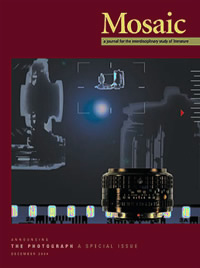Issue 37.4
Overview

Special Issue: The Photograph
Published: December 2004
Receive 50% off this issue with a 1-year subscription, or receive this issue FREE with a 2-year subscription if you subscribe now!
View the issue introduction or see the issue summary and contents below.
15 essays, totalling 336 pages
$22.95 CAD
This special issue features selected papers and three keynote presentations from Mosaic's March 2004 international interdisciplinary conference, The Photograph. The issue, like the conference, is bound to be another major international event. This is a color issue of 336 pages, available December 2004.
Light Writing: Portraiture in a Post-Traumatic AgeMIEKE BAL This essay explores the portrait, not as memory of the disappeared, but as both a record and an appeal, both recognition and validation, of subjects who are themselves traumatized. It confronts figurative portraits with works that retain the trace as basis of meaningfulness. | |
Shudder Speed: The Photograph as Ecstasy and TragedyDAVID FARRELL KRELL Aristotle, Augustine, and Heidegger describe the phenomenon of “suddenness.” Interpreters of Greek tragedy such as Hölderlin and Jacob Bernays relate suddenness to the cathartic effect of tragedy—violent agitation of the psyche followed by a restoration of calm. Does shutter speed in photography produce a similar effect? | |
Is a Door a Word?FRED WAH The following is a ramble that tries to recover the compounding cipher in image-text as an opportunity for recognition and surprise. A passage of in-betweenness, the photo-hyphen-text is played here as the liminal, the referential, and the punctuative, a little music at the heart of thinking. | |
Verbal/Visual Braids: The Photographic Medium in the Work of Julio CortázarDAN RUSSEK This essay shows the decisive role photography played in Julio Cortázar’s literary evolution. It examines the ways Cortázar appropriates some of the features of journalism and travel writing in his short fiction, fields that function as models for the complex interactions between verbal and visual representations. | |
Stories These Masks Could Tell: Literary References in the Photographs of Ralph Eugene MeatyardM. KATHRYN SHIELDS Meatyard’s Ambrose Bierce and Lucybelle Crater photographs may be seen as literary due to their narrative aspect and the fact that the underlying stories are especially compelling. Direct and indirect parallels with specific works of literature reveal that the masks in these photographs signify a transformation that embraces the tension between reality and representation. | |
The Girl No One Knew: Photographs, Narratives, and Secrets in Modern FictionJANICE HART Photographs frequently appear in fiction because their reputation for indexicality confirms our view of what the world, and the world of the novel, is like. However, in The Photograph, Penelope Lively uses the unexpected discovery of a photograph to confound, not confirm, everything her characters know about themselves and each other. | |
“The Camera Made Me Do It”: Female Identity and Troubling ArchivesJEANNE PERREAULT and PATRICIA LEVIN This essay reads the photographs and compositions of Montreal artist Nicole Jolicoeur, examining her use of famous nineteenth-century archival collections. It argues that Jolicoeur’s reconstructions of old images of women open aesthetic and ethical issues for viewers as well as for herself, culminating in a series of self-portraits. | |
‘The Transparent Eyeball’: On Emerson and Walker EvansCAROLINE BLINDER Taking Emerson’s “Nature” as its starting point, this paper argues that in Lincoln Kirstein’s and William Carlos Williams’s readings of Evans as a visionary artist of the vernacular, Emersonian ideals were always part and parcel of the search for an intrinsically American manifesto of photography. | |
Boredom, Repetition, Inertia: Contemporary Photography and the Aesthetics of the BanalEugénie Shinkle This essay explores the banal as a contemporary photographic aesthetic, examining banality in relation to notions of boredom and ennui. The “perceptual boredom” of the banal image—its resistance to emotional and critical engagement—is considered in relation to its content, style, and spatial structure. | |
Black, Not Blank: Photography’s (Invisible) Archives in John Edgar Wideman’s Two CitiesPETRA DREISER This essay examines the photographic practice at the heart of John Edgar Wideman’s Two Cities. Considering the photographs as a kind of archive, it suggests that they reflect the problematic framework of black visual representation in dominant American culture while simultaneously pointing to the possibility of a radical new vision. | |
The Architecture of the PhotographHELEN ROBERTSON Through discussion of photographic works and works of architecture, this essay uncovers conceptual structures underpinning the photographic process, considering in particular Thomas Ruff’s series of photographs of Mies van der Rohe’s buildings in relation to a self-reflexive engagement of the photographic. | |
Reconsidering Postmemory: Photography, the Archive, and Post-Holocaust Memory in W.G. Sebald’s AusterlitzRICHARD CROWNSHAW Theories of postmemory can lose sight of the specificity of acts of post-Holocaust remembrance and of the identities formed through these acts. By examining W.G. Sebald’s Austerlitz and its use of photography, this essay scrutinizes the theory, practice, and ethics of postmemory. | |
More Than Meets the Eye: Photographic Records of Humboldtian ImaginingsCATHERINE DE LORENZO and DEBORAH van der PLAAT Current photo-historiography largely ignores the influence on nineteenth century photographers of Alexander von Humboldt’s co-examination of poetry, painting, and the cultivation of exotic plants. This essay argues for a Humboldtian reading of selected photographs by the European-born Australian photographer John William Lindt (1845—1926). | |
Architectural Image and Idiom: Making LocalELIZABETH MUSGRAVE and DOUGLAS NEALE Using photographic images from South East Queensland mid-twentieth-century architecture, this essay investigates the translation and regeneration of modern themes into a local idiom that resonates with poetic qualities of pre-existent forms of inhabitation. It contributes to the discussion of the photograph’s role in communicating meaning in architecture through its potential to “reveal” the idiomatic. | |
The Hero of HeroinesMARGOT LEIGH BUTLER By way of “figuration,” “implicatedness,” and other interdisciplinary concepts, this essay contextualizes and critiques Lincoln Clarkes’s acclaimed book of photographs of unnamed women pictured as heroin addicts on Vancouver’s Downtown Eastside, where many women are missing and murdered. |